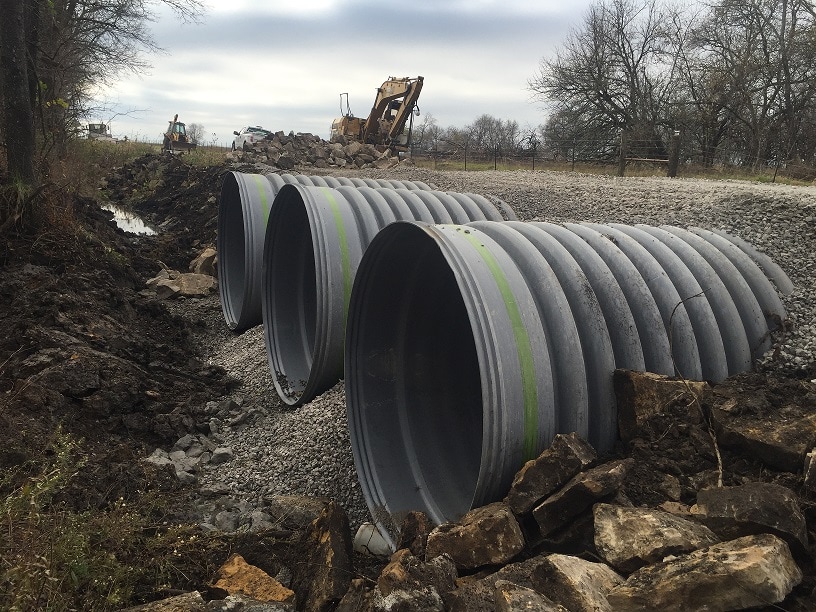Professional Culvert Installation for Long Lasting Framework
Professional Culvert Installation for Long Lasting Framework
Blog Article
Culvert Installation Made Easy: Step-by-Step Guide for Success
Installing culverts may look like an uncomplicated job, yet making certain an effective outcome calls for mindful preparation and implementation. From choosing the proper culvert dimension to incorporating correct water drainage actions, each action in the setup procedure plays an important function in the functionality and longevity of the culvert system. By adhering to a systematic approach and taking notice of crucial details, the installation can continue smoothly, lessening prospective issues down the line. Keep tuned to discover the essential steps and factors to consider that can make culvert setup a seamless and effective endeavor.
Selecting the Right Culvert Dimension
Selecting the proper culvert size is critical for making certain effective water flow and architectural integrity in culvert installment projects - Pad Construction. The dimension of the culvert directly affects the flow ability of water through the structure. A culvert that is also little can cause flooding and overflow, while one that is too huge may result in decreased water speed, possibly causing sediment buildup and blockages
To establish the best culvert dimension, variables such as the watershed area, optimal circulation prices, and hydraulic effectiveness demand to be thoroughly considered. Estimations based on these specifications aid in selecting a dimension that can properly handle the expected water volume while lessening the risk of blockages and structural failing.
It is vital to get in touch with engineering guidelines and requirements to make sure that the selected culvert dimension fulfills the task needs and local regulations (Pad Construction). By picking the right culvert size, project managers can enhance water circulation, avoid prospective concerns, and boost the total efficiency and long life of the culvert installation
Preparing the Installment Website
Efficient culvert installment necessitates careful prep work of the installment website to make certain optimum architectural support and capability. Prior to starting the installment procedure, it is essential to get rid of the website of any type of particles, plants, or blockages that might hamper the culvert's positioning. Ensuring a level structure is crucial for the correct placement and stability of the culvert. This might involve grading the website to produce a smooth, also surface that can sufficiently sustain the weight of the culvert and any type of expected loads. In addition, appropriate compaction of the soil underneath the culvert is needed to stop working out or shifting over time.
Moreover, it is essential to think about variables such as soil structure, groundwater degrees, and ecological impacts when preparing the installment site. Conducting a detailed site evaluation can aid recognize any kind of potential difficulties or threats that might affect the culvert's performance. By taking the time to prepare the setup website appropriately, you can help guarantee a successful culvert setup that meets structural needs and ensures long-term functionality.
Positioning the Culvert Correctly

The grade at which the culvert is put is critical for maintaining a correct slope for water flow. In addition, the culvert should be oriented correctly to make sure that the inlet and electrical outlet are in the correct areas. Pad Construction.
Backfilling and Compacting the Dirt
Correct backfilling and compaction of the dirt around the culvert is vital to guarantee stability and stop prospective concerns in the future. Once the culvert is correctly placed, important link the next important step is to backfill the area around it with ideal product. The backfill product should be without rocks, debris, and natural matter to avoid damage to the culvert. It is suggested to utilize granular material such as sand or gravel for backfilling, as it supplies good drainage and compaction residential or commercial properties.
After positioning the backfill product, it is essential to small it in layers of uniform thickness. Using a compactor or a mechanical meddle, small the soil gently to stay clear of harming the culvert. Compaction assists in lowering the opportunities of negotiation and guarantees uniform assistance around the culvert. It is crucial to small the dirt evenly on all sides of the culvert to keep its structural integrity.
Correct backfilling and compaction not only provide security to the culvert however also assist in stopping soil erosion and keeping the durability of the culvert system.
Making Sure Proper Water Drainage Integration
Incorporating reliable drainage options plays a vital duty in the general capability and durability of culvert setups. Appropriate water drainage integration is necessary for managing water flow, protecting against erosion, and ensuring the architectural honesty of the culvert system. To achieve this, it is crucial to design a thorough drainage strategy that thinks about variables such as the volume of water expected, the topography of the area, and the kind of soil present.

Furthermore, integrating features like disintegration control actions, such as riprap or plant life, can better boost the performance of the drain system. By very carefully preparing and executing these drainage services, culvert setups can work effectively and endure the test of time.
Verdict
In final thought, proper culvert installment is vital for maintaining effective drainage systems. By picking the best culvert size, preparing the setup site, positioning the culvert properly, backfilling and compacting the soil, and ensuring appropriate drainage assimilation, success can be achieved. Adhering to these steps will aid make sure the longevity and performance of the culvert, ultimately adding to the overall success of the water drainage system.
Report this page